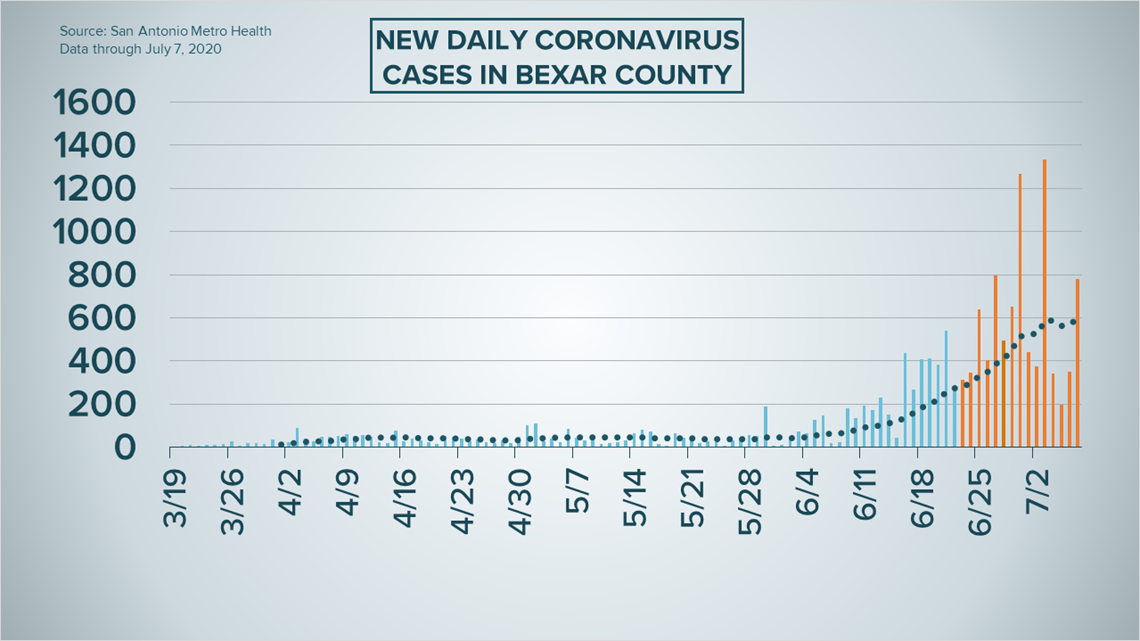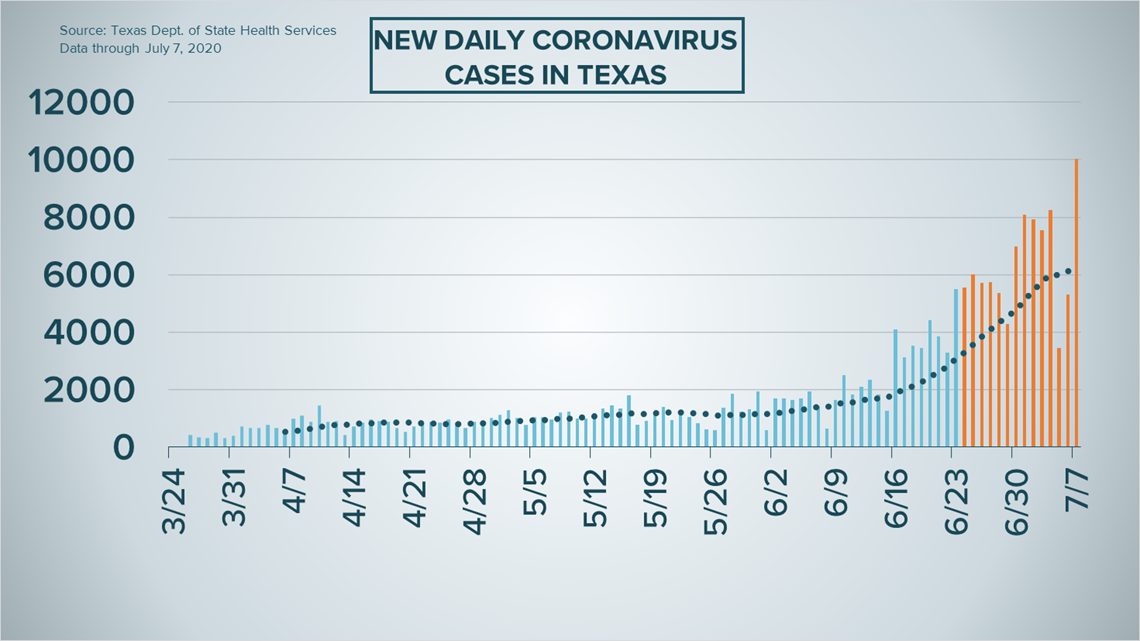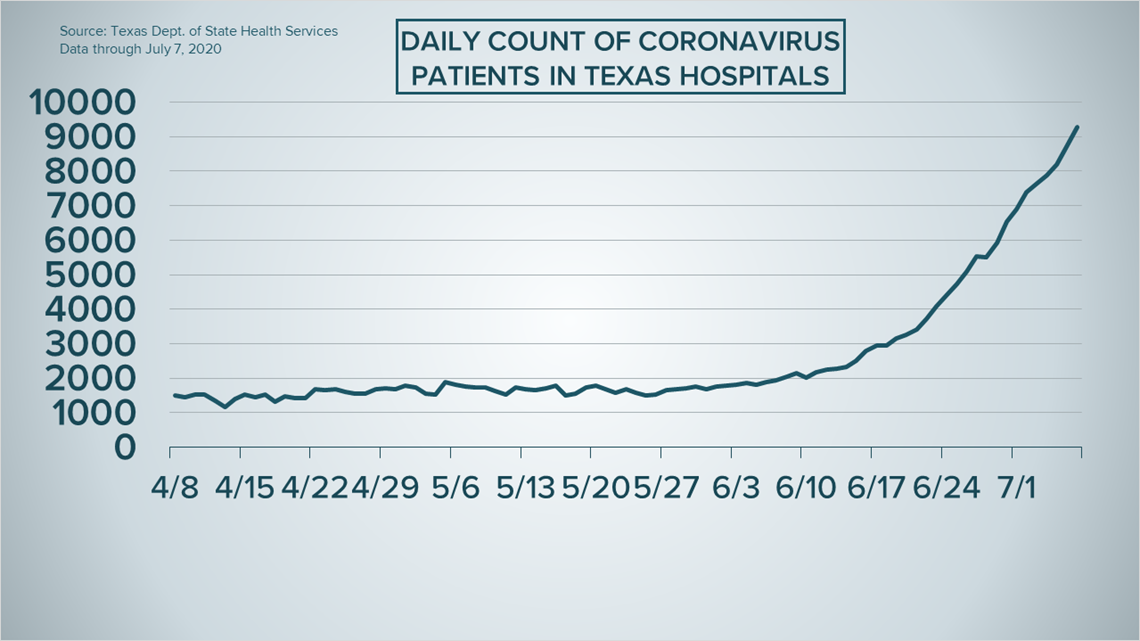SAN ANTONIO — We're tracking the latest numbers from the coronavirus pandemic in San Antonio and across Texas. Here are the latest numbers reported by Bexar and surrounding counties:
- Bexar County: 778 new cases and five more deaths from COVID-19 were reported Tuesday. There is now a total of 15,880 cases and 137 fatalities in the county.
- Comal County: Comal County reported 103 new cases of coronavirus Wednesday morning (bringing the total to 1,092) and confirmed that six COVID-19 deaths are tied to nursing homes. On Tuesday, Comal County health officials reported 82 new cases of the coronavirus, bringing the total there to 989. Nine people have now died in the county, while 338 have recovered. The positivity rate 12.61%, down slightly from Friday but up from 10.28% a week ago.
- Hays County: The county reported 50 new coronavirus cases on Tuesday. As of July 7, the Hays County Local Health Department confirms a total of 3,243 cases in the county, 2,652 of which remain active. The county's death toll remains at 10.
Bexar County reports the full numbers daily at 7 p.m.
How Bexar County is trending:
We're tracking how many coronavirus cases are confirmed in Bexar County each day from the time San Antonio Metro Health began reporting cases more than two months ago. Graphing those daily case numbers along a 14-day moving average provides an accurate picture of the curve in the San Antonio area and the direction we're heading amid the coronavirus.
On Tuesday, Mayor Ron Nirenberg reported 778 newly confirmed cases of the coronavirus in Bexar County, calling the development "a little bit dejecting" given the lower daily totals of the past three days.
Nirenberg also confirmed five more virus-related deaths, bringing the local death toll to 137.


Meanwhile, 1,235 COVID-19-positive county residents are in local hospitals Tuesday afternoon; 389 of those are in intensive care and 221 are on ventilators. Nirenberg says just 11% of staffed hospital beds are ready to take a patient.


Coronavirus in Texas
State health officials reported a daily count of at least 10,000 new coronavirus cases for the first time in the ongoing pandemic, setting a grim new high with a total of 10,028 new diagnoses over the past 24 hours. The previous high was just over 8,200 on Saturday.
Meanwhile, another 60 virus-related deaths were reported in Texas—also the largest number the state has seen in the pandemic.


The number of new hospitalizations, meanwhile, continued a troubling trend that began in early June in the Lone Star State. As of Tuesday afternoon, 9,286 COVID-19-positive patients are in Texas hospitals, an increase of 588 over Monday.


Latest Coronavirus Headlines
- Congress created coronvirus aid then reaped the benefits, government data shows
- Protective gear running low again, doctors and nurses warn
- Abbott on schools starting back up in the fall: 'We will need to be flexible'
- Three things you should do if you're caring for someone with coronavirus
- The race to develop a coronavirus vaccine
- US notifies UN of withdrawal from World Health Organization
- More than 50 members of San Antonio area church test positive for coronavirus
- Oktoberfest 2020 in Fredericksburg postponed until next year
- 'We need you more than ever' | San Antonio Food Bank asking for volunteers
Coronavirus symptoms
The symptoms of coronavirus can be similar to the flu or a bad cold. Symptoms include fever or chills, cough, shortness of breath or difficulty breathing, fatigue, muscle or body aches, headache, new loss of taste or smell sore throat, congestion or runny nose, nausea or vomiting and diarrhea, according to the Centers for Disease Control.
Most healthy people will have mild symptoms. A study of more than 72,000 patients by the Centers for Disease Control in China showed 80 percent of the cases there were mild.
But infections can cause pneumonia, severe acute respiratory syndrome, kidney failure, and even death, according to the World Health Organization. Older people with underlying health conditions are most at risk.
On June 25, the CDC expanded the list of groups at a higher risk of severe illness due to coronavirus.
Experts determined there was consistent evidence these conditions increase a person's risk, regardless of age:
- Chronic kidney disease
- COPD (chronic obstructive pulmonary disease)
- Obesity (BMI of 30 or higher)
- Immunocompromised state (weakened immune system) from solid organ transplant
- Serious heart conditions, such as heart failure, coronary artery disease, or cardiomyopathies
- Sickle cell disease
- Type 2 diabetes
The CDC believes symptoms may appear anywhere from two to 14 days after being exposed.
Human coronaviruses are usually spread...
- Between people who are in close contact with one another (within about 6 feet).
- Through respiratory droplets produced when an infected person coughs, sneezes or talks. These droplets can land in the mouths or noses of people who are nearby or possibly be inhaled into the lungs.
- Some recent studies have suggested that COVID-19 may be spread by people who are not showing symptoms.
Help stop the spread of coronavirus
- Stay home when you are sick.
- Eat and sleep separately from your family members
- Use different utensils and dishes
- Cover your cough or sneeze with your arm, not your hand.
- If you use a tissue, throw it in the trash.
Lower your risk
- Wash your hands often with soap and water for at least 20 seconds. If soap and water are not available, use an alcohol-based hand sanitizer.
- Avoid touching your eyes, nose, and mouth with unwashed hands.
- Avoid close contact with people who are sick.
- Clean and disinfect frequently touched objects and surfaces.
- The CDC recommends wearing a mask or cloth face covering if you have to be out due to an essential service or essential activity such as going to the grocery store.
- If you are 60 or over and have an underlying health condition such as cardiovascular disease, diabetes or respiratory illnesses like asthma or COPD, the World Health Organization advises you to try to avoid crowds or places where you might interact with people who are sick.

